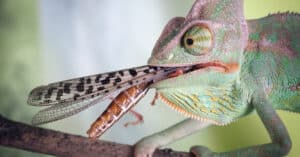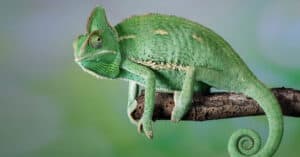Horns are a unique feature that can come in all shapes and sizes. Certain animals have horns that stick straight up, while others curve backward, make a spiral shape, or point outwards. Most common in hoofed mammals, a bone core surrounded by a thick layer of horn keratin, covered in a keratinized epidermis, makes up horns. Animals often use them to help defend themselves against predators. They also defend themselves from other animals of the same species during times of mating and competition for female partners. Here are the ten best types of horned animals and some fun facts about them!
Bison

American bison are the national mammal of the United States.
©Tim Malek/Shutterstock.com
Named the national mammal of the United States, bison are massive. Males weigh up to 2,000 pounds as adults, and females (cows) weigh up to 1,000 pounds. At this weight, and a height ranging from four to six feet, bison are the largest mammal in the United States.
Despite being incredibly large, bison are also extremely agile. The mammals can run up to 35 miles per hour and are also strong swimmers and high jumpers. Bison can live to be up to 20 years old. They are herbivores, their diet consisting mainly of grass and leaves.
The densest populations of them are within Yellowstone National Park. Despite that, they also live in other areas with wide open plains for grazing and traveling in herds. In addition to defense, bison use their horns to break through snow and ice during cold months. This allows them to access grass for nutrition and sustenance. Bison horns are small and curve upwards next to their ears.
Pronghorn
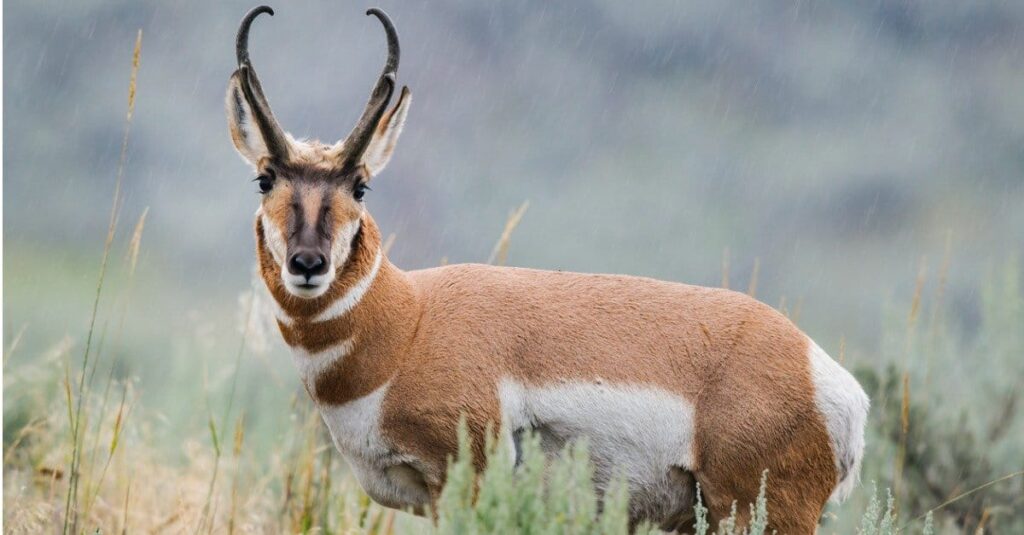
While not true antelopes, pronghorns are sometimes called American antelopes.
©BGSmith/Shutterstock.com
Residing throughout the western United States and Canada, the pronghorn is a much smaller horned mammal. They weigh between 90 and 120 pounds and stand at around three and a half feet tall. Due to their relatively small size and habitat in wide open spaces like grassy plains and meadows, pronghorns can be an easy target for predators. These mammals are the fastest land animals in the entire western hemisphere, though. They can reach speeds of up to 60 miles per hour. Further, they can sustain speeds of 30 to 40 miles per hour for long distances.
Pronghorns usually mate in the summer, and males will use their horns to fight off other antelope looking for mates. Male pronghorns have horns that range from 12 to 20 inches in length and curve inwards toward one another. Female pronghorns have much smaller horns, measuring just three to four inches in length. Also, their horns stick directly upwards rather than forming into any unique shape.
Mouflon
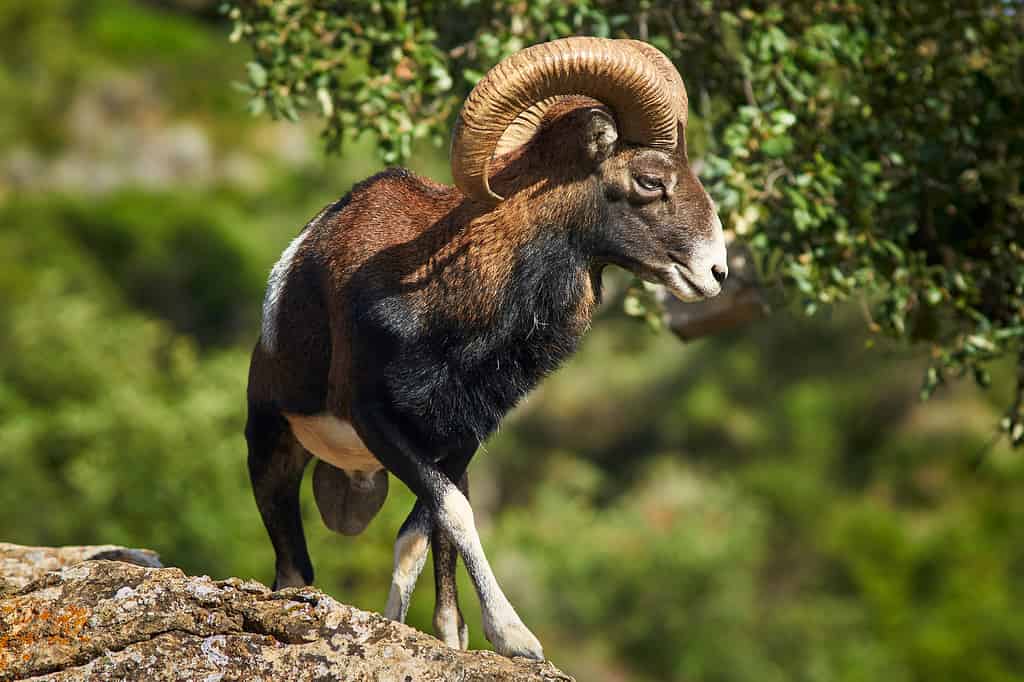
Grasslands, forests, and mountains are the types of regions mouflons call home.
©Jesus Noguera photography/Shutterstock.com
Native to the Caspian region of eastern Europe, the mouflon is a wild sheep species. It is thought to be the ancestor of most domesticated sheep today. Weighing on average 200 pounds and standing at around three feet tall, mouflons are mid-sized mammals with extremely thick, reddish-colored coats. They have a lifespan of between eight to 12 years.
Mouflons mainly live in temperate climates containing features like grasslands, forests, and mountains. They are herbivores, living off of various different grasses and shrubberies in their domestic ecosystems.
Male and female mouflons live separately in packs and only come together during their mating season every autumn. While female mouflons have very small horns, males have horns that can reach up to 25 inches in length. Male mouflons’ horns curve backward against their head forming a sickle shape and continue to grow throughout their entire lives. The size of a mouflon’s horns determines his status within a pack. Those with larger horns have more power in their group.
Rhinoceros

Rhino horns are prized items in some cultures
©JONATHAN PLEDGER/Shutterstock.com
Also called “rhinos,” rhinoceroses are some of the largest mammals in the entire world. These beasts range in height from five to seven feet and can be anywhere from eight to 13 feet long. On top of their astonishing size, rhinos weigh between three and five tons, which is heavier than most cars! The rhinoceros is a solitary animal rarely seen in groups larger than ten. It can mainly be found in southern and eastern Africa and some tropical parts of Asia.
While massive, the rhinoceros is still extremely agile, able to reach speeds of almost 30 miles per hour when a threat is sensed. In order to communicate with one another, rhinos create infrasonic frequencies that are inaudible to humans but easily interpreted by others of the same species.
Unlike many other horned animals, rhinos are classified by a large singular horn that can measure anywhere from eight to 25 inches in length. Rhinoceroses mainly use their horns to fight off threats and intimidate one another during mating season. Unfortunately, their horns are a large contributor to the endangerment of their species, as many poachers will hunt rhinos in order to sell their horns for profit.
Kudu
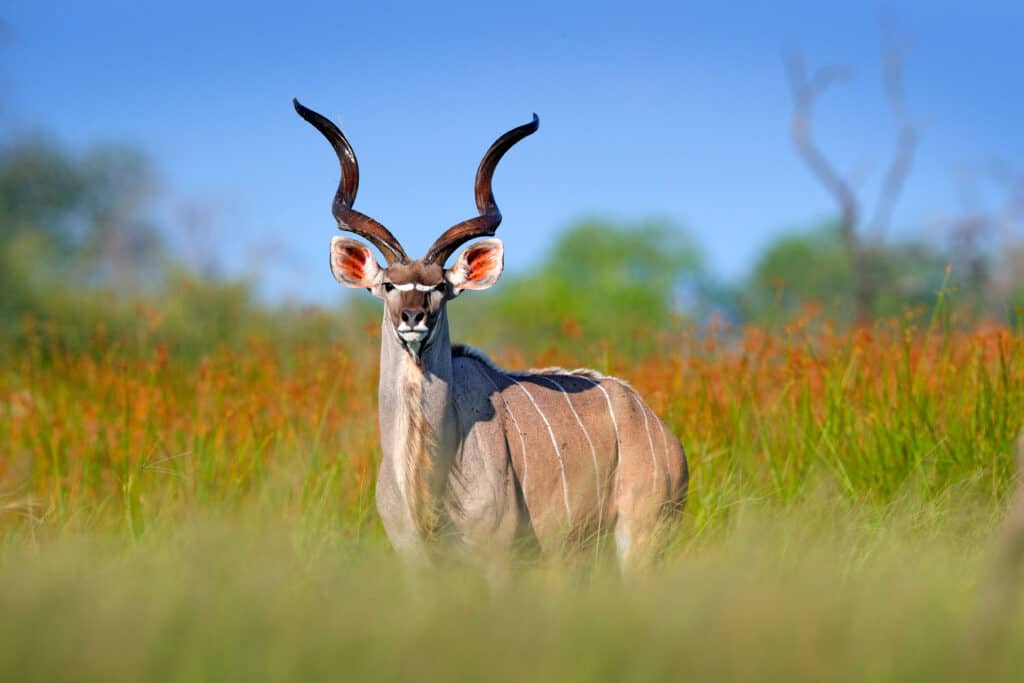
Male kudus’ horns spiral upward, sometimes reaching a massive six feet long.
©Ondrej Prosicky/Shutterstock.com
Native to southeast Africa, kudus are a type of antelope with a grayish-colored coat and unique horns. Male kudus can weigh up to 230 pounds while females are much smaller, weighing just around 50 pounds on average. These mammals are fairly solitary, with males sometimes forming small groups to hunt and females staying in packs of ten or less when caring for their offspring. Male and female kudus only interact during the mating season, which takes place during the winter.
Kudus are fairly peaceful creatures. They camouflage with their surrounding by standing still, blending into the background with their neutral-colored coats. During times of threat, though, kudus are extremely fast. In fact, they are able to reach speeds of up to 60 miles per hour when running from predators and other dangers.
The antelopes are herbivorous, feasting mainly on leaves and grass in their habitats and seeking nourishment from native fruits during the dry season. Male kudus are most distinguishable by their horns, which spiral upward from their heads. They can also reach around six feet in length, spiraling two to three times in the process.
African Buffalo

They may be herbivores, but African buffalo are aggressive.
©nelik/Shutterstock.com
Located throughout most of Africa, this species of buffalo is extremely large. They weigh anywhere from 660 to 1,840 pounds and stand around five feet tall. These mammals live between 11 and 22 years in the wild. They’re also herbivores, mainly eating grass and leaves found in their habitats.
While older male buffalo sometimes form smaller groups and stray off on their own, African buffalo are known for traveling in large herds that can reach almost 500 in number. They travel in herds in order to take care of their young and protect themselves from predators in the African wilderness such as lions and tigers.
While they are not predators of any other animals, these beasts are known for being aggressive when threatened. African buffalo can run at speeds of up to 37 miles per hour, and males use their horns to fend off attackers and other dangers. Males have horns that stem from the middle of their head and grow out to either side, curving down against their head before swooping back up at the end. These horns form a sort of helmet that provides protection and allows the buffalo to attack predators more effectively. Male buffalo can have horns that measure up to seven feet in length, and help determine dominance during mating season as well as status within their respective herds.
Markhor

The spiraled horns of markhors are truly striking.
©BearFotos/Shutterstock.com
Markhors are some of the largest of the wild goat species, characterized by their long horns and reddish-gray coats. They are native to central Asia and live in mountainous regions like the Himalayas. While markhors are herbivores that mainly feast on twigs and shrubs, their name means “snake-killer” in Persian due to their ability to crush venomous snakes with their massive hooves.
Female markhors can weigh anywhere from 70 to 88 pounds, while male markhors are much larger, weighing up to 240 pounds. These goats range between two to four feet in height and have a lifespan of up to 13 years. Females live in herds of 30 to 100 and are only joined by males during the mating period in the fall season. Markhors’ horns are a defining feature, and they are even believed to contain medicinal properties in some nearby cultures. Female markhors have horns that can reach up to two feet in length, while male horns are much longer — reaching up to five feet and spiraling directly upward from the top of their head.
Jackson’s Chameleon

Only male Jackson’s chameleons grow horns. Females don’t have horns.
©reptiles4all/Shutterstock.com
Also known as the three-horned chameleon, Jackson’s chameleons are much smaller than any of the other animals on this list. These reptiles weigh around two to three pounds and on average, they measure a foot in length. They are native to the jungles of east Africa, but can also be found in tropical areas like Hawaii, Florida, and California. Jackson’s chameleons can live up to 10 years due to their ability to change the color of their skin to blend in with their surroundings and hide from predators.
They have a carnivorous diet, consuming mainly insects and bugs and sometimes small birds and lizards. These chameleons usually mate in the summer, and they give birth to up to 30 babies at a time. While female Jackson’s chameleons do not have horns, males are identifiable by three horns facing forward out of their heads. Males use these horns to defend their territory from predators and other chameleons, fighting others off by pushing them from trees and prodding them with their horns.
Gemsbok
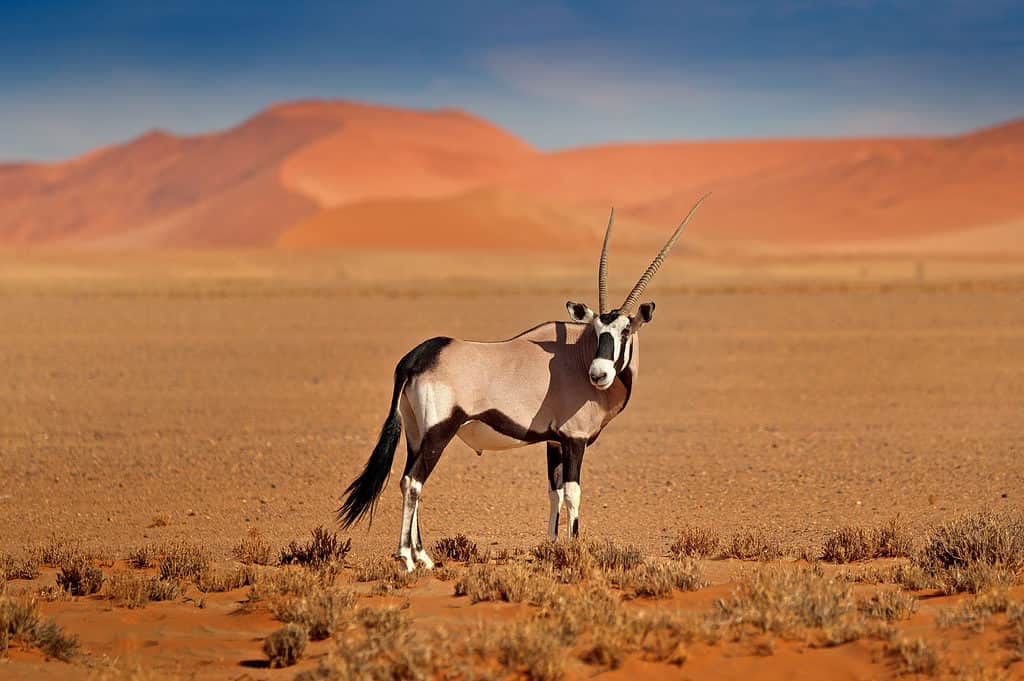
Living in herds between 10 and 40, gemsbok are quite social.
©Ondrej Prosicky/Shutterstock.com
The gemsbok is a large antelope with a tan-colored coat decorated with black and white markings. These creatures are much bigger than other antelopes, weighing between 220 and 540 pounds and standing four feet tall. Gemsbok are native to southern Africa, thriving in arid climates such as deserts and mountainous regions. They are herbivores, living mainly off of grasses and roots, and occasionally eat wild melons and cucumbers in order to satisfy their water intake.
Gemsbok are very social animals, living in herds of 10 to 40 with both males and females. When threatened, gemsbok can reach speeds of up to 37 miles per hour, making them extremely agile despite their large size. They do not have a specific mating season, but continually mate year-round, with males often trying to intimidate others in order to secure a mating partner. Both male and female gemsbok have long, thin horns that curve slightly backward off of the top of their heads and end in a sharp point. Their horns are usually around 33 inches (almost three feet!) in length. Females mainly use their horns to protect their young from predators and other threats, while males use theirs to intimidate other gemsbok and defend their territory.
Texas Longhorn
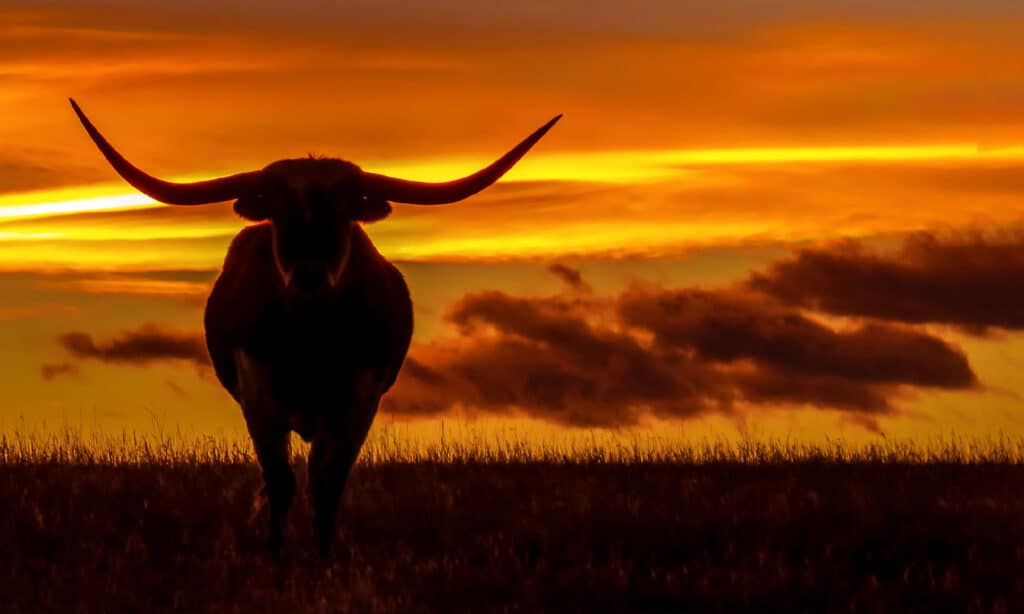
Able to reach about 2,200 pounds, Texas longhorns are massive beasts.
©iStock.com/DawnKey
Located mainly in southwestern regions of the United States, the Texas longhorn is iconic amongst other breeds of cattle. Texas longhorns are massive, with females weighing between 600 and 1,400 pounds, and males weighing up to 2,200 pounds. The cattle can live up to 25 years and are mainly domesticated, living on farms throughout the United States and other parts of the world. The beasts are thought to be descendants of cattle from Iberia, brought over to the island of Hispaniola by Christopher Colombus in the 15th century.
They stand at around five feet tall and are herbivores, following a diet consisting mainly of grass and weeds. The most distinguishable aspect of the Texas longhorn, however, is its horns. Bulls have horns that measure around 100 inches (over eight feet!) in length, which were used to scare off predators when the mammals were living in the wild. The horns jut out to either side of the animal’s head, curving upwards at the ends.
Conclusion
Horns distinguish many animals from others because of their unique shapes and sizes. While they may seem trivial, every horned animal is able to utilize the appendages to ensure their safety. They also display them as a symbol of pride to other members of their species.
The photo featured at the top of this post is © Armensl/Shutterstock.com
Thank you for reading! Have some feedback for us? Contact the AZ Animals editorial team.




